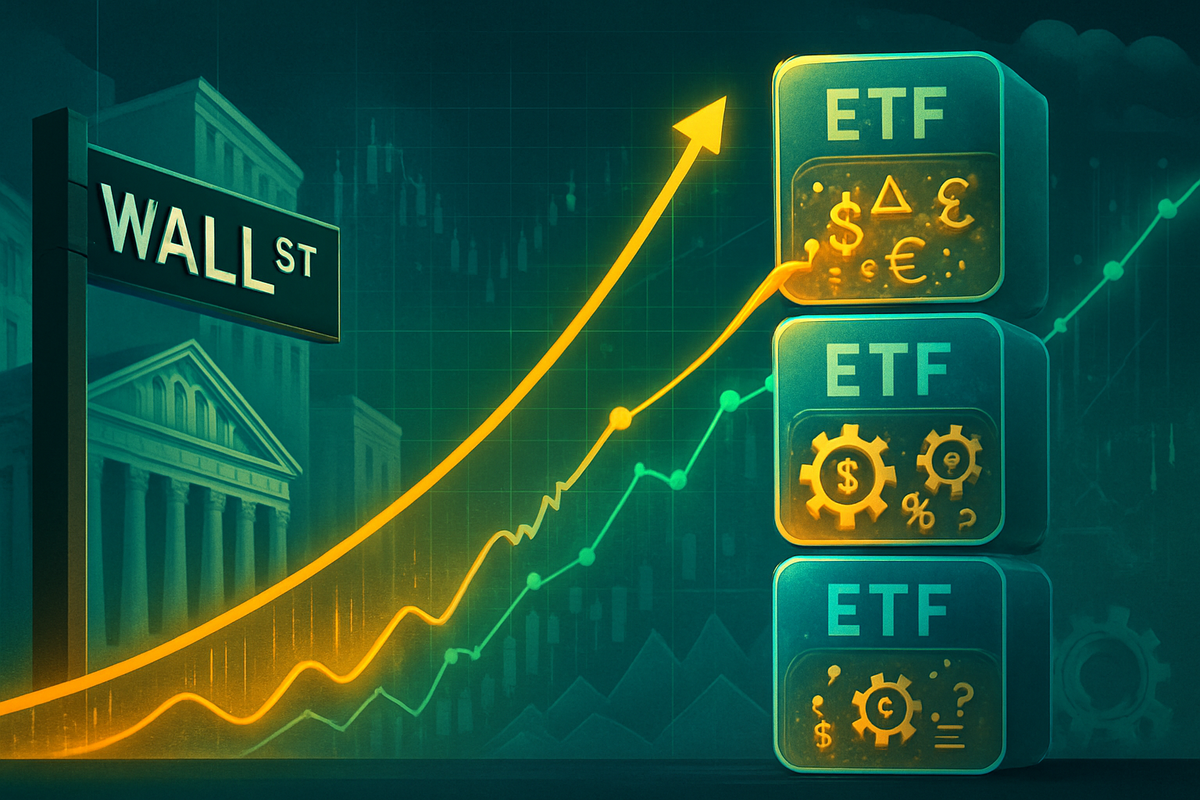
In a significant evolution of investment strategies, Wall Street is increasingly embedding complex autocallable structured products into Exchange Traded Funds (ETFs), a move that democratizes access to these sophisticated instruments for a broader investor base. This aggressive push is a direct response to the pervasive "race for yield," as investors desperately seek enhanced returns in a market environment where traditional fixed-income options offer meager income. The immediate implications are a double-edged sword: while these derivatives-powered ETFs promise attractive, often double-digit, coupon payments, they also introduce unique risks, including capped upside potential and the possibility of principal loss under specific market conditions.
This strategic shift, exemplified by the recent launch of the Calamos Autocallable Income ETF (NYSEARCA: CAIE) in June 2025, marks a pivotal moment in democratizing structured products. Traditionally, autocallable notes were over-the-counter (OTC) instruments, largely inaccessible to retail investors due to high minimums and illiquidity. By packaging them into an ETF wrapper, firms are offering daily liquidity and lower entry barriers, fundamentally altering how investors can access equity-linked income strategies. However, this accessibility also places a greater onus on investors to thoroughly understand the intricate mechanics and inherent risks of these derivatives.
The Ascent of Autocallable ETFs: A Deep Dive into Market Dynamics
The integration of autocallable structured products into the ETF ecosystem represents a calculated response by financial institutions to persistent investor demand for higher income in a low-yield world. The structured note market, a significant segment of the derivatives landscape, saw over $104 billion in issuance in 2024, with autocallables accounting for more than two-thirds of this volume. The broader derivative income and defined outcome ETF market has exploded from a modest $3.5 billion in 2019 to a staggering $179 billion today, highlighting the appetite for these types of strategies.
The timeline leading to this moment has seen a gradual but accelerating innovation in the ETF space. While defined outcome ETFs, which use options to cap upside for downside protection, have existed for several years, the direct inclusion of autocallable structured notes within an ETF is a more recent phenomenon. The launch of the Calamos Autocallable Income ETF (NYSEARCA: CAIE) by Calamos Investments in June 2025 was a landmark event, being the first U.S.-listed ETF to explicitly track a portfolio of autocallable structured products. This was quickly followed by reports of other prominent firms, such as Innovator Capital Management and First Trust, exploring or preparing similar offerings, signaling a burgeoning trend.
Key players in this evolving landscape include asset managers like Calamos Investments, who are pioneering these new products, and investment banks that structure the underlying autocallable notes. Regulators, particularly the Securities and Exchange Commission (SEC), are also critical stakeholders, tasked with ensuring adequate disclosure and investor protection for these complex products. Initial market reactions have been largely positive from an asset-gathering perspective, with CAIE quickly attracting significant capital, underscoring the strong investor appetite for enhanced yield. However, some market commentators and financial advisors have voiced concerns regarding the complexity of these products and the potential for retail investors to misunderstand their nuanced risk-reward profiles. The allure of high coupon payments, often averaging 14-14.7% annually for products like CAIE, can overshadow the inherent risks, such as limited upside participation and the possibility of principal loss if the underlying asset breaches a predefined "knock-in" barrier.
Corporate Fortunes: Winners and Losers in the Autocallable ETF Craze
The proliferation of autocallable ETFs is poised to create distinct winners and losers among public companies and financial institutions, recalibrating competitive dynamics across the financial services sector.
Potential Winners:
- Asset Managers Pioneering Autocallable ETFs: Firms like Calamos Investments (NASDAQ: CLMS, hypothetical ticker as they are privately held but for illustrative purposes) and potentially Innovator Capital Management (privately held) and First Trust (privately held) are at the forefront of this trend. By being early movers in offering these high-yield products, they stand to gain significant market share and attract substantial assets under management (AUM). Their ability to innovate and deliver sought-after yield solutions positions them for considerable growth in a competitive ETF landscape. The fees generated from managing these complex funds will directly boost their revenues.
- Investment Banks and Structurers: Major investment banks that specialize in structuring and underwriting autocallable notes will see increased demand for their services. Banks such as JPMorgan Chase & Co. (NYSE: JPM), Goldman Sachs Group Inc. (NYSE: GS), Morgan Stanley (NYSE: MS), and Citigroup Inc. (NYSE: C) are prominent players in the structured products market. As more asset managers seek to launch autocallable ETFs, these banks will benefit from the increased volume of note issuance, earning fees from the creation and distribution of these underlying derivatives.
- Broker-Dealers and Financial Advisors: While there's a learning curve, broker-dealers and financial advisors who effectively understand and communicate the complexities and suitable applications of autocallable ETFs can differentiate their services. They can attract income-seeking clients by offering a novel approach to yield generation, potentially increasing client assets and advisory fees.
Potential Losers (or those facing new challenges):
- Traditional Fixed-Income Managers: Managers heavily invested in traditional bond funds and other lower-yielding fixed-income strategies may face outflows as investors migrate to autocallable ETFs in pursuit of higher returns. Companies like PIMCO (owned by Allianz SE, XTRA: ALV) or BlackRock, Inc. (NYSE: BLK), while diversified, might see some competitive pressure on their core fixed-income offerings if they don't adapt or offer similar yield-enhancing alternatives.
- Covered Call ETF Providers: While not necessarily "losers," existing covered call ETF providers, such as those from Global X Funds (part of Mirae Asset Financial Group) or JPMorgan Chase & Co. (NYSE: JPM), might face increased competition. Autocallable ETFs offer a different risk-reward profile, potentially more attractive yields, and distinct downside protection mechanisms compared to covered calls, which could divert some investor capital.
- Retail Investors Without Proper Understanding: The biggest potential "losers" could be individual retail investors who, lured by high yields, invest in these products without fully grasping the embedded risks. The complexity of autocallables – including their knock-in barriers, autocall features, and limited upside – can lead to unexpected principal losses or missed market rallies, resulting in financial disappointment. This could also lead to reputational risk for the industry if widespread investor dissatisfaction emerges.
The increased adoption of autocallable ETFs will undoubtedly reshape product offerings and investment flows, pushing financial institutions to innovate or risk losing ground in the relentless quest for yield.
Broader Significance: Reshaping the Investment Landscape
The burgeoning trend of integrating autocallables into ETFs extends far beyond a mere product innovation; it signifies a profound shift in how financial institutions address investor demand for yield and how retail investors access sophisticated derivatives. This development fits squarely into broader industry trends of financial engineering, product democratization, and the ongoing search for non-traditional income sources in a persistent low-interest-rate (or volatile interest-rate) environment.
The potential ripple effects are substantial. Competitors in the income-generating ETF space, particularly those offering covered call strategies or traditional fixed-income products, will face increased pressure to innovate or risk losing market share. This could lead to a wave of new, similarly complex, derivatives-powered ETFs entering the market, further diversifying the investment landscape but also potentially increasing systemic complexity. Partners, such as custodians and trading platforms, will need to adapt their systems and educational materials to accommodate these more intricate products.
Regulatory implications are a critical consideration. The Securities and Exchange Commission (SEC) will likely intensify its scrutiny of these products, focusing on investor disclosure, suitability, and the potential for misrepresentation of risks. There is a fine line between providing access to sophisticated strategies and ensuring that retail investors fully comprehend the inherent complexities. Policy debates around product transparency, investor education requirements, and even potential restrictions on certain types of derivatives for retail investors could emerge, especially if market downturns expose widespread misunderstandings or losses. The current date of 10/13/2025 means that regulators have had some months to observe the initial launches and market reception, and their response will be crucial.
Historically, this trend echoes past instances of financial innovation that democratized complex instruments. The rise of mortgage-backed securities (MBS) in the 1980s and 1990s, while ultimately leading to systemic issues in 2008, initially offered new avenues for yield and diversification. Similarly, the growth of high-yield bond funds in the 1980s allowed retail investors access to corporate debt that was previously difficult to acquire. The key lesson from these precedents is that while innovation can unlock opportunities, it also necessitates robust risk management, transparent disclosure, and comprehensive investor education to mitigate potential systemic vulnerabilities and protect individual investors. The difference here is that autocallables are equity-linked derivatives, introducing a different set of risks compared to credit-based instruments.
What Comes Next: Navigating the Future of Derivatives-Powered ETFs
Looking ahead, the integration of autocallables into ETFs presents a dynamic landscape with both promising opportunities and significant challenges for investors, asset managers, and regulators.
In the short-term, we can anticipate a continued surge in new autocallable ETF offerings from various asset managers. The success of early movers like the Calamos Autocallable Income ETF (NYSEARCA: CAIE) will undoubtedly spur competitors to launch similar products, leading to a more crowded and competitive market. This immediate future will also likely see increased marketing efforts from product providers, emphasizing the attractive yield potential, which will be met with growing calls for enhanced investor education and clearer risk disclosures from financial advisors and consumer advocacy groups. Regulators, particularly the SEC, will be closely monitoring these developments, potentially issuing guidance or even proposing new rules to ensure investor protection, especially concerning the marketing and sales practices of these complex products.
For the long-term, the trajectory of autocallable ETFs could lead to several potential scenarios. One possibility is their entrenchment as a mainstream income-generating tool, particularly if they consistently deliver on their yield promises without significant principal erosion during moderate market downturns. This could lead to a broader acceptance of derivatives-powered investment strategies among retail investors. Alternatively, a significant market correction that triggers widespread "knock-in" events and principal losses for these ETFs could lead to a backlash, potentially curbing their growth or prompting stricter regulatory oversight. This would necessitate strategic pivots from asset managers, perhaps towards more conservative structures or a renewed focus on simpler income strategies.
Market opportunities will emerge for sophisticated investors and advisors who can accurately assess the risk-reward profile of these products and integrate them appropriately into diversified portfolios. Challenges will arise for those who fail to adapt, particularly traditional fixed-income managers and those who cannot effectively communicate the nuances of derivatives to their client base. We might also see the development of more complex "structured solutions" within the ETF wrapper, moving beyond just autocallables to other multi-leg option strategies designed to achieve specific defined outcomes.
Potential scenarios and outcomes include:
- Mainstream Adoption: If these ETFs prove resilient and deliver consistent income, they could become a staple in income-focused portfolios, leading to further innovation in structured product ETFs.
- Regulatory Clampdown: A period of significant investor losses due to market volatility or misunderstanding could trigger a regulatory response, potentially slowing growth or increasing compliance burdens.
- Niche Product Status: Despite initial enthusiasm, if the complexities and risks outweigh the benefits for a broad investor base, autocallable ETFs might settle into a more niche role, appealing only to a segment of sophisticated investors.
The coming months will be crucial in determining how these derivatives-powered investment strategies evolve and integrate into the broader financial ecosystem.
MarketMinute Wrap-Up: High Yield, Higher Scrutiny
The strategic pivot by Wall Street to integrate autocallable structured products into Exchange Traded Funds marks a significant development in the ongoing "race for yield." This derivatives-powered investment strategy offers investors access to potentially higher income streams, often in the double-digit range, a compelling proposition in a market hungry for returns. However, the key takeaway is that this enhanced yield comes with inherent complexities and risks, including capped upside potential and the possibility of principal loss if underlying assets breach predefined barrier levels.
Moving forward, the market will be characterized by continued innovation in the structured product ETF space, alongside intensified scrutiny from regulators and a heightened need for investor education. The success and longevity of these products will hinge not only on their performance but also on the industry's ability to transparently communicate their intricate mechanics and associated risks to a broad investor base. The current date of 10/13/2025 places us in a period where initial market reactions have been observed, and the next phase will likely involve regulatory responses and further product refinement.
For investors, the coming months will demand vigilance and a deep understanding of these products. It's crucial to look beyond the attractive coupon rates and thoroughly assess the embedded downside risks, autocall features, and how these products fit into a holistic portfolio strategy. The evolution of autocallable ETFs represents both an opportunity for enhanced income and a challenge in navigating increasingly complex financial instruments. What investors should watch for in coming months includes regulatory pronouncements, the performance of these ETFs in various market conditions, and the emergence of new, potentially even more sophisticated, derivatives-based investment solutions.
This content is intended for informational purposes only and is not financial advice






